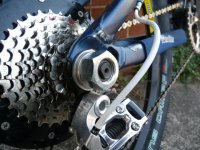If the axle spins out, it often twists the wires up ripping the insulation apart on multiple wires, allowing them to short together. When this happens between a phase wire and a hall, it can destroy not only the hall sensor in the motor (easily replaced), but also the hall input on the controller itself (which isn't fixable; requires a new controller).
I'd recommend opening the motor, then pulling the wire *in* thru the axle slot, until you are past the damaged area. THen cut that damaged end off, and rewire from the undamaged part to the different spots the wires went to before.
Then at least you know all the wires are intact.
After that, you can test the hall sensors themselves, via the info at http://ebikes.ca in the Learn - Troubleshooting tab.
If they're ok, then retest the controller with the motor. If it still doesn't work, the controller is probably fried.
These MXUS 450x's can be quite high torque motors, if supplied with enough phase current. If you're also using regen, it rocks the axle back and forth and that's much harder on the axle and dropout / torque arm than just forward acceleration.
A very tight fitting and securely mounted torque arm on *each side* is pretty much necessary for these.
But if you push them hard enough, even that isn't enough:
At least you didn't break the axle yet.

I've done that to two different MXUS, a 4504 and a 4503; the latest:
https://endless-sphere.com/forums/viewtopic.php?f=2&t=67833&p=1404238#p1402078
My torque arms (actually clamping dropouts) held on fine, but the axle coudln't handle all the forces.


